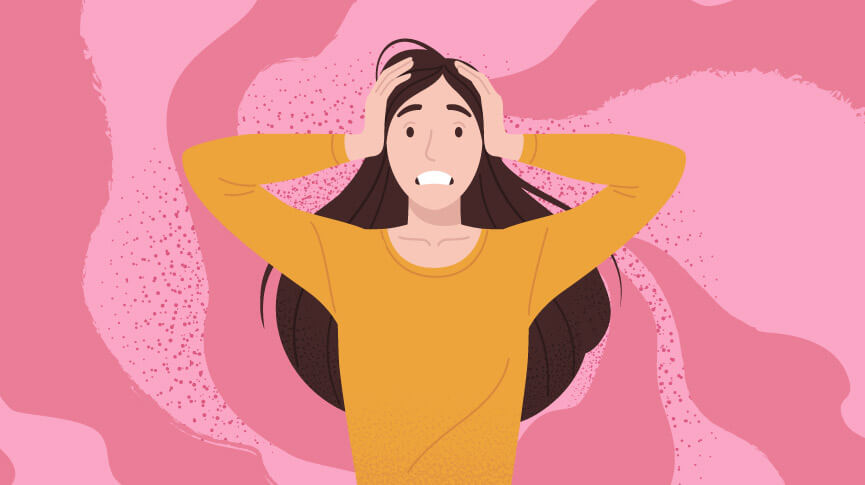OCD in Women

‘OCD’ is a term that’s thrown around often very casually. You might hear people say ‘I need to have my desk a certain way, I’m so OCD.’ or ‘I have to sweep my floors every day, I feel so OCD.’ or ‘If I don’t floss my teeth my OCD gets triggered.’ The topic of OCD has become synonymous with wanting to stay clean or organized. While these could be manifestations of OCD, Obsessive Compulsive Disorder is a real, diagnosable condition that can greatly impact someone’s quality of life and well-being. The casualness with which people often discuss OCD can minimize the lived experience for people that have this mental health condition. It can also make their disorder seem less real, legitimate, or make it more difficult for them to access proper treatment. What exactly is Obsessive Compulsive Disorder, how does it manifest differently in women, and how can you treat it? We’re here to find out.
What is OCD?
Obsessive-Compulsive Disorder, OCD, is a chronic and long-lasting disorder affecting about 1.2% of adults in the United States – where there tends to be a slightly higher rate than there is global. People who have this disorder experience uncontrollable and recurring thoughts and behaviors that they feel the need to repeat over and over. When you break down the name, the “obsessive” part is reflected in intrusive thoughts, while the ‘compulsive’ part is seen with repetitive behaviors. People with the disorder may experience symptoms of obsessive thoughts, compulsive behaviors, or both. Obsessions are repeated thoughts, and/or mental images that cause anxiety. These can interfere with everyday life including work, school, and relationships. These obsessive thoughts may lead to compulsions like repetitive handwashing, compulsive counting, and repeatedly checking things like whether the door is locked or the oven is off.
People with OCD may also experience fear of germs and contamination, they may want things to be symmetrical or in what they consider to be the perfect order. They may also have taboo thoughts around harming themselves or others or ones related to sex. Some people with OCD also develop a tic disorder, which can cause them to do face grimacing, repetitive eye movements, blink repeatedly, throat clearing, or make grunting sounds.
Some of these behaviors may seem commonplace, especially amid the pandemic. What makes them different in someone with OCD is that they feel like they don’t have control over their thoughts or actions, even when they recognize that something is off. While they may get brief relief from the anxiety caused by their obsessions, they don’t get pleasure from action on compulsions. Another key indicator of OCD is that these behaviors greatly interfere with their daily life and relationships, and take up a huge chunk of time.
How Does OCD Affect Women?
Like many other mental health disorders, the global rates for OCD are slightly higher in women than men, 1.5% vs 1%, respectively. While this may seem like a small percentage, that means that 50% more women than men are affected by this disorder. Things like global sexism, disparities in power and income, and increased rates of trauma for girls and women all come into play when looking at why cis women are affected more commonly than cis men.
Another factor that can increase a woman’s chance to develop OCD is pregnancy. Postpartum mood disorders include Postpartum OCD. This affects about 1-3% of postpartum people and can result in new parents experiencing obsessive thoughts and rituals about the baby and its safety. This may include consistently intrusive thoughts about the baby being hurt by accident or on purpose, or even of the parent harming the baby themselves. They may feel compelled to constantly check on the baby or obsessively research.
Most people with OCD are diagnosed by age 19. There is an increased risk in people who experienced childhood trauma. People may also have a higher risk if they have a family history of OCD and other mental health disorders. While there is limited research on OCD in people who are non-binary or transgender, it’s important to not undermine the experience of these populations, unfortunately, the science just hasn’t caught up yet.
Treating OCD
Although people make light of OCD, it is a real disorder that greatly impacts the lives of those affected, as well as their loved ones.
That being said, there are so many options when it comes to treatment, here are some to explore:
- Avoid triggers like alcohol and stress.
- People with OCD may also have other mental health conditions like anxiety disorders or depression. It’s important to treat these as well.
- Address and treat any underlying trauma through modalities like EMDR.
- CBT, cognitive-behavioral therapy.
- Stress management through breathwork and yoga.
- In some cases, people find relief through psychiatric medications.
If you are experiencing symptoms of OCD, please seek help from a medical provider or licensed mental health professional. Healing isn’t linear, and treatment can take a long time, even years. It can take time to find the right balance of providers, medications, or other tools, but you can change and heal.

Natasha (she/her) is a full-spectrum doula and health+wellness copywriter. Her work focuses on deconstructing the shame, stigma, and barriers people carry around birth, sex, health, and beyond, to help people navigate through their lives with more education and empowerment. You can connect with Natasha on IG @natasha.s.weiss.


